In refractive cataract surgery, when a central goal of the procedure is good UCVA, there is little room for error in the IOL power calculation. Current-generation biometers and modern formulas have reduced inaccuracy, and they have made it possible to hit refractive targets more consistently.
Keratometry, however, remains a significant source of variability and error, primarily due to fluctuations of the ocular surface. Surgeons' accuracy in measuring keratometry is now often limited by an unstable ocular surface, particularly in the older cataract population. We have all had postoperative refractive surprises that, upon rechecking keratometry readings (Ks), gave new measurements that would have yielded the desired outcome. The only way to know that the Ks used in IOL power calculations are stable and consistent, therefore, is to repeat the measurement at a separate visit, not unlike what is done to assess stability after a patient ceases contact lens wear.
I have been obtaining repeated IOLMaster scans (Carl Zeiss Meditec, Inc.) on all refractive cataract surgery patients (anyone opting for the correction of astigmatism or presbyopia) for over 5 years. I began this practice with the goal of eliminating significant outliers—and that alone justifies doing it—but the extra scan also contributes to a very tight mean absolute error (MAE) in my results.
In a recent preliminary analysis of 93 consecutive eyes that received a Tecnis Multifocal IOL (Abbott Medical Optics Inc.), my MAE was 0.283 D, with 92% of eyes within 0.50 D of plano and 73% of eyes within 0.25 D of plano, which is comparable to some of the best results reported in the published literature.1
CHOOSING THE IOL
If the IOLMaster results from two separate days are consistent, I simply run my power calculations and pick the appropriate IOL. As the difference between the two scans increases, so does the likelihood of missing the refractive target. When the difference in the keratometry or predicted refraction is greater than 0.35 D, I consider repeating the IOLMaster measurement a third time.
When the two scans are in close agreement, I can use the biometry from either. Rather than randomly choose one of the two scans, however, I run power calculations for both (Figures 1 and 2). Because IOLs are available in 0.50 D steps, I will choose the IOL power that is predicted to be closest to plano in both scans. For the example in Figure 2, when looking at the SRK-T formula, a +11.50 D ZMB00 (Tecnis Multifocal 1-Piece IOL) will give me a predicted refraction of plano with the measurements from scan 1 and +0.11 D with the measurements from scan 2. In addition to measuring twice, I like to perform two calculations by using the Holladay 2 formula in addition to SRK-T.2 In Figure 2, the Holladay 2 shows the +11.50 D ZMB00 to have a slightly negative predicted refraction, which balances the slightly positive refraction predicted by the SRK-T. The average of all four predicted refractions is therefore closest to plano.
With regard to predictability, I have found that, the closer the two biometric measures are in predicted IOL power, the more precise my results are. If there is a calculated predicted difference in refraction of more than 0.35 D between the two IOLMaster scans, the predicted error will be about 0.50 D. To me, this would justify a third measurement, reconsideration of the multifocal IOL, or a discussion with the patient about the potential for an enhancement.
PRACTICAL CONSIDERATIONS
I like to include the Holladay 2 formula for premium IOLs, but it is important to note that this formula requires the manual entry of refractive data for improved accuracy. To compare power calculations quickly across several different biometry readings, I find it more convenient to use the SRK/T formula calculations as a firstorder comparison.
The biggest challenge in repeating biometry measurements, of course, is a logistical one. In my practice, I schedule a separate visit to repeat the IOLMaster scan. If I have noted signs of significant dry eye disease at the initial examination, I may recommend an artificial tear like Blink Tears (Abbott Medical Optics Inc.) and take advantage of this second visit to re-examine the ocular surface. The repeat visit is typically a technician-only encounter that is included in my refractive correction package.
As the IOLMaster and the Holladay IOL Consultant Software (Holladay Consulting) do not have a provision for recording multiple scans for a given patient, I label the second scan “PatientLastName_02 with PatientID_02” to distinguish it from the first scan and to avoid overwriting data. Having multiple preoperative visits and scans generates more paperwork for me to review, but when done in an organized fashion, it is very manageable and well worth the effort.
CONCLUSION
Basing power calculations on repeated scans allows me to predict and improve postoperative accuracy. There is much discussion about whether laser cataract surgery improves refractive accuracy. Simply repeating the biometry is a readily available, inexpensive approach that can increase predictability and reduce refractive error with no capital investment at all.
Daniel H. Chang, MD, is in private practice at Empire Eye and Laser Center in Bakersfield, California. He is a consultant to Abbott Medical Optics Inc. Dr. Chang may be reached at (661) 325-3937; dchang@empireeyeandlaser.com.
- Lawless M, Bali SJ, Hodge C, et al. Outcomes of femtosecond laser cataract surgery with a diffractive multifocal intraocular lens. J Refract Surg. 2012;28(12):859-864.
- Narváez J, Zimmerman G, Stulting RD, Chang DH. Accuracy of intraocular lens power prediction using the Hoffer Q, Holladay 1, Holladay 2, and SRK/T formulas. J Cataract Refract Surg. 2007;32(12): 2050-2053.


